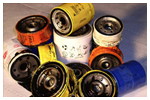 |
|
Please note: This summary is provided to help you understand the regulations. Consult the references provided for links to the full text of the regulations.
This section covers management and disposal/recycling of used oil filers. Both federal and state regulations are discussed.
Who is covered by the regulations? U.S. EPA and all states have environmental regulations that affect the management practices and disposal of used oil filters. Any business that generates used oil filters is subject to these rules. At one time, used oil filters were regulated like most other wastes generated by businesses; they were subject to the hazardous waste rules, including the requirement to make a hazardous waste determination. In the 1990's EPA amended the regulations to exempt non-tern plated used oil filters from regulation as a hazardous waste if they were properly drained of oil. When the draining procedures are followed, used non-tern plated oil filters may be disposed of or recycled as scrap metal. Tern-plated filters are coated with an alloy of lead and tin which makes them a potentially RCRA hazardous waste if they are discarded. However, these filters are also exempt from the federal hazardous waste rules if they are properly managed and recycled as scrap metal. If they are discarded rather than recycled, then the hazardous waste rules apply. At one time, tern-plated filters were commonly used in trucks and heavy equipment, but they were mostly phased out in the 1990's. For non-tern-plated filters, the key to achieving non-hazardous status is "proper draining." This must be accomplished by one of the following methods as required at 40 CFR 261.4(b)(13):
State regulations may vary from federal standards and there are also differences from state to state. For example, some states allow for disposal of used oil filters in landfills if they have been "hot drained," while other states have entirely banned used oil filters from landfills. Therefore it is important that you check with you state environmental agency with regard to their rules and policies for disposal of used oil filters. All states allow for recycle of used oil filters. A useful source of state information is the TERC state used oil section. Maintenance operations should consider investing in an oil filter draining station. These vary in their level of sophistication, with the most basic units being a drain pan that attaches to a 55-gal drum. In operation, filters are punctured in the dome end of the filter or through the anti-drain back valve with a suitable tool (e.g., punch hammer) and allowed to drain over a screened surface; oil drips through the screen and enters a collection drum. Puncturing the filter breaks the vacuum inside the filter and allows the "trapped" oil to be recovered for recycling. For best results, drain used oil filters in a warm room for a minimum of 12 hours. Both the used oil and filter should be recycled. Even after puncturing and draining for an extended time period, some oil is retained in the filter due to its design. Oil filters crushers can be used after draining to remove most of the residual oil, which is captured in a collection tank below the crusher. These units also decrease the volume of the filter by about 75%, which reduces storage space requirements. None found at this time.
|
 Used Oil Filters
Used Oil Filters